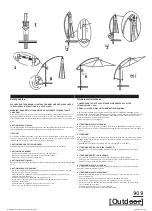
6
7
WARNING
- Never leave the child unattended.
- Always use the child restraint and table attachment systems.
- Always check the security and the stability of the product before use.
- This product is intended for children able to sit up unaided, up to a maximum weight of 15 kg
- The table must not be covered with a tablecloth or any other item that could prevent the fixings from attaching correctly.
Keep the frame and surface of the table clean and dry.
- Regularly check the tightening devices, turning them tighter if required.
- Do not use the product if any components are broken or missing.
- Only use other accessories or spare parts that have been recommended by the manufacturer or distributor.
- Do not attach the product in a place where the child could push the product backwards by kicking against the table,
another chair or any other similar structure, as the product could become detached from the table.
- This product cannot be used with all types of table. Do not use on a glass table, an unstable table top, a drop-leaf table,
single-leg table, games table, camping table or any other table that cannot provide a sufficiently stable base.
Ensure that the table will not tip over when the product is attached and used. Keep the packaging materials out of reach of
children.
- Maximum weight: 15 kg.
UNFOLDING THE HOOK-ON HIGH CHAIR (DIAGRAMS 1, 2 AND 3)
Unfold the arms (C) until you hear a click (Diagrams 1 and 2). Then fold them outwards (Diagram 3).
FIXING THE HIGH CHAIR ONTO THE TABLE (DIAGRAMS 4, 5 AND 6)
1 - Slide the chair onto the table. All parts of the upper arms (B) must be in contact with the surface of the table (Diagrams 4
and 5). If this is not the case, do not use the product.
2. Turn the tightening screw (D) as far as it will go to fully grip the arms (B and C) onto the table (Diagram 6).
ADJUSTING THE HEIGHT OF THE HIGH CHAIR (DIAGRAM 7)
1 - Unfasten the cover using the press-studs (I).
2 - Press the height adjustment system (E) located on the lower arm (C).
3 - Slide the arm (C) upwards to reach the required height. It will click as it locks into place.
4 - Fasten the cover using the press-studs (I).
5- Repeat steps 1, 2, 3 and 4 on the other side.
ADJUSTING THE HARNESS
Sit your child in the high chair, then fasten and adjust the safety harness using the clip (F).
FOLDING THE HIGH CHAIR (DIAGRAMS 8, 9 AND 10)
1 - Fold the arms (B and C) inwards (Diagram 8).
2 - Press the height adjustment system (E) on each arm (C) to unlock them (Diagram 9).
3 - Fold the arms (B and C) onto the chair frame (A) (Diagram 10).
CARE AND WASHING INSTRUCTIONS
This product requires very little maintenance. CLEANING AND MAINTENANCE MUST ONLY BE CARRIED OUT BY AN ADULT.
The chair has a cover made from hard-wearing fabric which is completely removable and washable at 30°. Do not use
bleach, do not tumble dry. Do not iron or dry clean.
1 - Unfasten the cover (H) using the press-studs (I) located on each side.
2 - Fully remove one arm (C) from the frame (A). To do so, press the height adjustment system (E) (Diagram 11) to unlock the
arm (C) from the frame (A). Slide the cover (H) along the frame (A) until it is completely removed.
3 - To put the cover (H) back on, slide it along the frame (A). Replace the arm (B) onto the frame until you hear it lock into place
and fasten the press-studs (I) around the frame (A) on each side.
Check the chair often for loose screws, worn parts, torn fabrics, or stitching that has come undone. If there is any damage to
the chair, do not use it and keep it out of the reach of children
• Clean plastic parts regularly with a damp cloth. Do not use solvents or other similar products.
• Change or repair parts if necessary. Only use spare parts recommended by Badabulle.
• Protect the product from the elements, water, rain or snow.
• Excessive exposure to the sun or heat may cause parts to fade.
EN
AVERTISSEMENTS
- Ne jamais laisser l’enfant sans surveillance.
- Toujours utiliser les systèmes de retenue de l’enfant et de fixation à la table.
- Toujours vérifier la sécurité et la stabilité du produit avant utilisation.
- Ce produit est destiné aux enfants capables de se tenir assis tous seuls, jusqu’à un poids maximum de 15 kg
- La table ne doit pas être recouverte d’une nappe ou de tout autre objet susceptible d’entraver le fonctionnement correct des
éléments d’ancrage. Maintenir propres et sèches la structure et la surface de la table.
- Régulièrement vérifier les dispositifs de serrage et, si nécessaire, les resserrer.
-Ne pas utiliser le produit si certains de ses éléments sont cassés ou manquants.
- Ne pas utiliser d’autres accessoires ou pièces de rechange que ceux recommandés par le fabricant ou distributeur.
- Ne pas fixer le produit en un endroit où l’enfant pourrait repousser le produit en poussant la table, une autre chaise ou toute
autre structure similaire avec ses pieds, car le produit pourrait se décrocher de la table.
- Ce produit ne peut pas être utilisé avec n’importe quelle table. Ne pas l’utiliser sur une table en verre, un dessus de table
instable, une table à abattant, une table à un seul pied, une table de jeu, une table de camping ou toute autre table n’offrant
pas un support suffisamment stable. S’assurer que la table ne basculera pas lorsque le produit y sera fixé et utilisé. Garder
les matériaux d’emballage hors de portée des enfants.
- Poids maximum : 15 kg.
DÉPLIAGE DU SIÈGE DE TABLE (SCHÉMAS 1, 2 ET 3)
Déplier les bras (C) jusqu’à entendre un clic (Schéma 1 et 2). Puis les rabattre vers l’extérieur (Schéma 3).
INSTALLATION DU SIÈGE SUR LA TABLE (SCHÉMA 4,5 ET 6)
1
- Faire glisser le siège sur la table, la totalité des bras supérieurs (B) doit être en contact avec la surface de la table (Schéma
4 et 5). Ne pas utiliser le produit dans le cas contraire.
2
- Tourner la vis de serrage (D) au maximum afin de serrer correctement les bras ( B et C) à la table. (Schéma 6)
RÉGLAGE EN HAUTEUR DU SIÈGE (SCHÉMA 7)
1 -
Ouvrir la housse à l’aide des boutons à pression (I).
2 -
Appuyer sur le système de réglage en hauteur (E) situé sur le bras inférieur (C).
3 -
Faire coulisser le bras (C) de bas en haut jusqu’à la hauteur souhaitée. Entendre un clic de verrouillage.
4 -
Refermer la housse à l’aide des boutons pressions (I).
5 -
Réaliser les étapes 1,2,3 et 4 de l’autre côté.
RÉGLAGE DU HARNAIS
Asseoir votre bébé dans le rehausseur, puis attacher et ajuster le harnais de sécurité à l’aide du clip (F).
PLIAGE DU SIÈGE (SCHÉMA 8, 9 ET 10)
1 -
Rabattre les bras (B et C) vers l’intérieur (Schéma 8).
2 -
Appuyer sur le système de réglage en hauteur (E) de chaque bras (C) pour désenclencher le verrouillage (Schéma 9).
3 -
Rabattre les bras( B et C) sur l’armature du siège (A) (Schéma 10).
ENTRETIEN ET INSTRUCTION DE LAVAGE
Votre produit nécessite un minimum d’entretien. LES OPERATIONS DE NETTOYAGE ET D’ENTRETIEN DOIVENT ETRE
EFFECTUEES UNIQUEMENT PAR DES ADULTES.
Le siège est pourvu d’une housse en tissu résistant entièrement amovible et lavable à 30°. Ne pas utiliser d’eau de Javel, ne
pas passer au sèche-linge. Ne pas repasser ou nettoyer à sec.
1 -
Ouvrir la housse (H) à l’aide des boutons à pression (I) situés de chaque côté (I).
2 -
Retirer totalement un bras (C) de la structure (A). Pour cela, appuyer sur le système de réglage en hauteur (E) (Schéma 11)
pour déverrouiller le bras (C) de la structure (A). Faire coulisser la housse (H) de la structure (A) jusqu’à son retrait complet.
3 -
Pour remettre la housse (H), la faire coulisser sur la structure (A). Replacer le bras (B) sur la structure jusqu’à entendre le
clic de verouillage et refermer les boutons pressions (I) autour de la structure (A) de chaque côté.
Vérifier souvent le siège pour s’assurer qu’il n’y ait pas de vis desserrées, de pièces usées, de tissus déchirés, ou de points
décousus. Si le siège est endommagé, ne pas l’utiliser et la tenir hors de la portée des enfants.
• Nettoyer régulièrement les parties en plastique avec un chiffon humide, ne pas utiliser de solvants ou d’autres produits du
même type.
• Faire remplacer ou réparer les pièces si nécessaire. N’utiliser que des pièces détachées conseillées par Badabulle.
• Protéger le produit contre les agents atmosphériques, l’eau, la pluie ou la neige.
• Une exposition excessive au soleil ou à la chaleur peut provoquer la décoloration des pièces.
FR
Summary of Contents for B072000
Page 9: ...22 FR ...



























